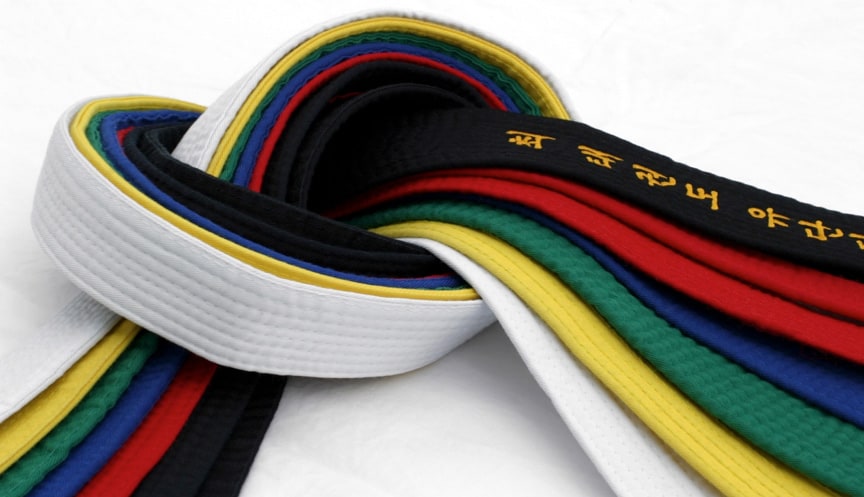Thanks for taking advantage of our special offer!
One of our team will be in touch as soon as possible to get your special offer underway. If you'd rather call us in the meantime, please feel free to give us a call on 01264 333007.
What’s the story of my coloured belt?
Author: Master Bonthuys
This is a GREAT question! In the “good old days”, students were given a new white belt when they started their martial arts journey, and simply dyed it a new colour as they worked their way up in the ranks. This is why the colours progress from lightest to darkest.
This made it easy to change the color for each promotion, and meant that the student could physically SEE their progression within the system, and know how far from, or how close they are to the black belt.
Not long after Master B started training as an adult (he first started his training at the age of 9 in 1966!), the coloured belts were swapped and re-cycled between students at each grading (the instructor also kept a bag full of old sweaty belts).

Today, students are usually presented with a brand-new belt of a new colour when they advance at each new rank, and they can keep their old belts as a reminder of their journey each step towards the coveted black belt.
Different styles of martial art may use different colours, but essentially use the same belt and rank system from white to black belt.
The belt system

The belt (or ranking) system is one way of recognising a student’s experience and accomplishment throughout their training in the martial arts. Think of the belts as a ladder of success…
The Belt Colours and their meanings
In Tae Kwon Do (and Korean Martial Arts), each primary belt colour has a philosophical meaning at Martial Art World:
- White: Signifies innocence, as that of the beginning student who has no previous knowledge of Tae Kwon-Do.
- Orange: Signifies the rising sun with the morning’s dawn. Only the beauty of the sunrise is seen - rather than the immense power of the sun.
- Yellow: Signifies earth, from which a plant sprouts root as the Tae Kwon-Do foundation is being laid.
- Green: Signifies the plant’s growth, as Tae Kwon-Do skills begin to develop.
- Blue: Signifies heaven, toward which the plant matures into a towering tree as training in Tae Kwon-Do progresses.
- Red: Signifies danger, cautioning the student to exercise control and warning the opponent to stay away.
- Black: Opposite to white, therefore signifying maturity and proficiency in Tae Kwon-Do. Also indicates the wearer’s imperviousness to darkness and fear

When did this system start?
The systematic use of belt color to denote the student rank was first used in Japan by Jigoro Kano (the founder of judo). He first devised the colored belt system in the 1880s, and we use a similar ranking system today at Martial Art World.
Kup, a Korean term, is used to denote beginner grade within the Leadership Programme (Positive Start annd foundation levels use a slightly different system).
Each grade has a correlating number and belt color. The system counts down from 10 kup (white belt) to 1 kup (red belt with black stripe).
After that a student reaches black belt ranking, and the system counts up (black, 1st Dan, 2nd Dan etc, up to 9th Dan).

At MAW we follow the following Dan grade format for the levels of black belt:
- 1st, 2nd and 3rd Dan = Novice black belt
- 4th Dan = Expert
- 5th Dan = Master
- 8th Dan = Senior Master
- 9th Dan = Grand Master
Some oriental systems award the master grade at 4th Dan, some at 5th Dan, some at 6th Dan and some at 7th Dan (Olympic WTF TKD = 4th Dan for master)
How long is it for you to finish your coloured belt journey? This will allow you to train with the black belts, and to begin a new pathway where the real learning starts! If you are already within the black belt circle, how long until your next Dan grading?
< Back to all Blog posts
LIMITED TIME OFFER: 2 weeks of training for £20*
Simply click the button alongside to get 2 weeks of training for just £20.